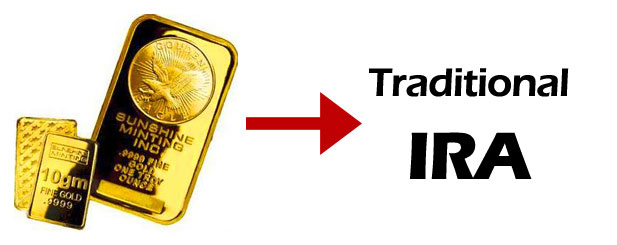Investing in Gold Through a Traditional IRA
Disclosure: We are reader-supported. If you purchase from a link on our site, we may earn a commission. Learn more

If you have a traditional IRA, chances are that you already understand the importance of retirement savings and diverse investment choices. Have you considered taking the next step and adding physical assets like gold and silver bullion to your portfolio? Here, we'll go over the differences between traditional IRAs and self-directed IRA accounts, how precious metals investing works, and how you can safeguard your savings against stock market or currency collapse.
Table of Contents
What is a Traditional IRA?
Traditional Individual Retirement Accounts (IRAs) were established in 1974 through the Employee Retirement Income Security Act, or ERISA. IRAs are tax-advantaged investment vehicles designed for retirement savings; money contributed to an IRA is not taxed and grows tax-free until a withdrawal is made.
Unlike 401(k) plans, Traditional IRAs are not sponsored by an employer. Rather, individuals need to qualify in order to open and contribute to their own IRA, although the qualifications are quite simple: earn taxable income and be under the age of 70 1/2. That's it. (however, your contributions may or may not be deductible depending on your income level and access to other retirement accounts)
One drawback of an IRA (relative to other retirement accounts) is that they have fairly low contribution limits. For the 2024 tax year, individuals under the age of 50 can only contribute $7,000 per year, while those aged 50 and above can contribute $8,000.
As with other qualified plans, a 10% tax penalty is assessed if any money is withdrawn prior to the “retirement age” of 59 1/2, though there are some exceptions in the case of hardship. Withdrawals become mandatory at age 70 1/2, at which point you are also no longer eligible to make contributions.
While the investment choices for Traditional IRAs tend to be much more numerous than employer-sponsored accounts, your IRA custodian still can limit what you can choose. Additionally, the Internal Revenue Service (IRS) does not allow Traditional IRA money to be invested in physical assets like real estate or precious metal bullion.
You may not take out loans from an IRA.
Traditional IRA Rollover Guidelines, Rules & Limitations
Funding held in an IRA can be sent from one financial institution to another via a process known as a rollover. If account holders do not exceed the limit on one rollover per 365-day period (per account), then they can transfer money or assets between IRAs without incurring penalties or triggering a tax event. Therefore, money or assets from an existing Traditional IRA can be put toward a new self-directed IRA at no cost.
As always, there's a 10% early distribution fee (that operates as a kind of tax) for any withdrawal taken before the age of 59 1/2. However, you can circumvent this issue by doing a direct rollover between accounts, which deposits the funding from one IRA (or other account) to the new Traditional IRA without incurring penalties or even leaving a tax-sheltered environment.
Typically, those who want to fund a self-directed traditional IRA do so using an IRA-to-IRA rollover. To get started, investors have to select an IRS-approved third party custodian who, on behalf of the client, facilitates the transfer into a new IRA. The custodian then follows the instructions of the client and is legally obligated to execute their will and invest at their discretion.
Traditional IRA vs. Self-directed IRA vs. 401(k) vs. Other Retirement Accounts
Below, we've put together a useful table for comparing Traditional IRAs with Roth IRAs, 401(k)s, and other types of tax-advantaged retirement savings accounts:
| Plan Type | Sponsorship | 2025 Contribution Limit | Roth Option? | Allow Gold Stocks? | Allow Gold ETFs? | Allow Gold Bullion |
|---|---|---|---|---|---|---|
| 401(k) | Private Employer | $23,500 | Yes | Maybe | Maybe | No |
| Solo 401(k) | Self-employed | $70,000 | Yes | Yes | Yes | Yes |
| Keogh Plan | Self-employed or Unincorporated Employer | Depends on Type of Plan | No | Maybe | Maybe | No |
| 403(b) | Government or Non-profit Employer | $23,500 | Yes | Maybe | Maybe | No |
| 457(b) | Government or Tax-exempt Employer | $23,500 | Yes | Maybe | Maybe | No |
| SIMPLE IRA | Private Employer | $16,500 | Yes | Yes | Yes | Maybe |
| SEP IRA | Business Owners & Self-employed | $70,000 or 25% of Compensation | Yes | Yes | Yes | Maybe |
| Profit Sharing Plan | Private Employer | $70,000 or 100% of Compensation | No | Maybe | No | No |
| Money Purchase Plan | Private Employer | $70,000 or 25% of Compensation | No | Maybe | Maybe | No |
| Annuity | Individual | None | No | Maybe | Maybe | No |
| ESOP | Private Employer | Varies | Yes | Maybe | No | No |
| SARSEP | Private Employer | $70,000 or 25% of Compensation | No | Yes | Yes | Maybe |
| Traditional IRA | Individual | $7,000 / $8,000 | Yes | Yes | Yes | No |
| Precious Metals IRA | Individual | $7,000 / $8,000 | Yes | Yes | Yes | Yes |
| Thrift Savings Plan (TSP) | Government or Military | $23,500 + $7,500 Catch-up Contribution | Yes | No | No | No |
"Maybe", in this case, signifies that it's at the administrator's discretion whether the asset is eligible for inclusion.Types of Gold You Can Invest in Through a Traditional IRA
As mentioned above, Traditional IRAs come with strings attached in some cases. This is because account administrators and custodians can impose rules that restrict the types of assets you can invest in. However, there are a variety of safe assets that any IRA holder should be able to invest in freely:
- Individual stocks
- Individual bonds (corporate and government)
- Options
- Mutual fund shares
- Exchange Traded Fund (ETF) shares
- Certificates of Deposit (CDs)
- Money Market Fund shares
Unfortunately, investing in physical precious metals via a Traditional IRA is prohibited. Only indirect exposure via paper gold such as gold mining stocks allows traditional IRA investors to gain access to the gold or silver market.
Investing in Physical Gold vs. “Paper Gold”: Pros and Cons
Indirect exposure to the gold market is often achieved by investing in paper gold such as Gold Miners Index (GDX) or the BUGS Index (HUI) or even individual mining stocks. These securities represent shares of companies that are active within the precious metals industry. Although you don't own the underlying commodity (i.e. gold or silver), you do own assets whose value is dependent on its spot price.
There are plenty of risks associated with investing in paper gold. Simply put, paper silver or gold are much more volatile and are subject to knee-jerk reactions by investors. Since they're highly liquid assets, stocks can be easily bought or sold on a whim. Below, I've listed a few other risks unique to paper gold that physical gold doesn't share:
- Regulatory Risk – the regulatory environment for mining or exploration companies is uncertain and subject to change based on political will.
- Cost of Production Risk – land, labor, and equipment are expensive in the mining sector and the industry is capital intensive and therefore difficult to stay afloat.
- Management Risk – when a gold or silver mining company is bought out, new incompetent management can come in and mismanage the firm to the point of bankruptcy.
- Fiat Currency Risk – since stocks have to be bought or sold with fiat currencies such as US dollars or euros, they are susceptible to devaluation in the event of a monetary crisis or period of hyperinflation.
There's no comparison between paper gold and physical gold. In the former, there are several forms of counterparty risk that make investing in paper gold unwise for risk-averse investors who want true exposure to precious metals diversification. Gold or silver bullion do not carry any of these types of risk.
Should I Dedicate 5-20% of My Retirement Portfolio to Precious Metals?
How much of your portfolio you dedicate to precious metals will depend on numerous factors, such as your age, income, risk tolerance, and nearness to retirement. The closer you are to retiring, the more you should have invested in precious metals. On the higher end, a 15 to 20 percent exposure is commonly seen; on the lower, 5-15 percent.
Silver, gold, and platinum are hedges against market risk. Unlike stocks, they aren't extremely volatile and cannot be quickly bought and sold on a whim on public exchanges. Since you can't buy a gold bar on the NASDAQ, it's virtually impossible for the price of gold to swing as dramatically as stocks or cryptocurrencies.
Although gold is a safe diversifier and source of portfolio stability, it's also great for growth. Over the past couple of days, we've seen gold break all-time highs over $2,050 per ounce. Last year, the gains seen in the precious metals industry rivaled that of the S&P 500 or Dow Jones. For this reason, this asset class shouldn't just be seen as a protective tool, but also a catalyst for growth.
Sign up today to learn more.
If you're curious about investing in precious metals, take the next step toward becoming a knowledgeable precious metals owner: Sign up for our exclusive, insider newsletter. Every month, we'll bring you the inside scoop on news within the industry, as well as expert tips and price forecasts. Plus, it's 100% free.
Interested? Sign up now and we'll also send over a copy of our acclaimed PDF ebook 5 Scams to Avoid When Investing in Bullion Gold and Silver, so you can stay safe when investing in precious metals.



 Silver
Silver Gold
Gold Platinum
Platinum Palladium
Palladium Bitcoin
Bitcoin Ethereum
Ethereum
 Gold: $3,325.82
Gold: $3,325.82
 Silver: $36.46
Silver: $36.46
 Platinum: $1,365.19
Platinum: $1,365.19
 Palladium: $1,139.37
Palladium: $1,139.37
 Bitcoin: $111,339.83
Bitcoin: $111,339.83
 Ethereum: $2,773.71
Ethereum: $2,773.71